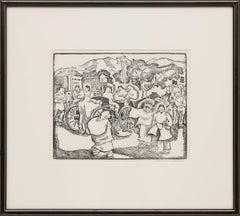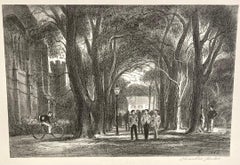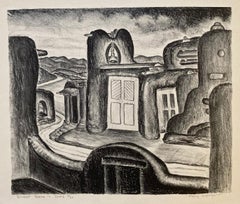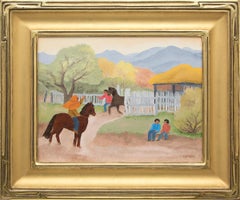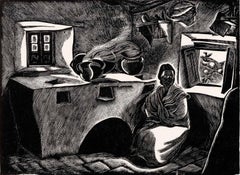Barbara Latham Art
American, 1896-1989
Beginning her career as a commercial artist, Barbara Latham travelled to Taos in 1925 seeking material for a greeting card. Serendipitously, she also found her life partner, Howard Cook, who was similarly looking for ideas for illustrations. Perhaps both were fueled in their quest by the tales of their mutual teacher, Andrew Dasburg, who knew of the energy and stimulation of this artist community. Observing local people and customs, Latham created genre scenes that offer a window into this now-vanished time and place. Her lively illustrations for numerous children’s books are a significant contribution to that graphic art in the mid-20th century.
Born in Walpole, Massachusetts, Latham’s student days included Norwich Art School and Pratt Institute in Brooklyn; but it was contact with the charismatic Dasburg at the Art Students League in Woodstock that opened her world and her view of art. Getting work with companies like Norcross Publishing and Forum magazine, she eventually made her way to Taos. Among all the spirited young artists gathered there, she met Howard Cook, who was designing illustrations for Willa Cather’s Death Comes to the Archbishop. The two married in Santa Fe and began a nomadic life together. The young couple made their way to Paris, a likely destination for modernist artists. Upon receiving a Guggenheim to study fresco painting in 1932, Cook, along with Latham, took an alternative direction and headed to Taxco, Mexico. At this time, Mexican muralists, such as Diego Rivera, were capturing the attention of progressive artists. During the Depression, both Cook and Latham aligned themselves with a populist ideal. Latham contributed work, such as Fording the Stream and Bear Family, to the American Artists Group, which was founded to produce original prints at affordable prices. When Latham settled in Taos, she was committed to an art of and for the people. Rather than a romanticized re-creation, her choice of subjects was based in common everyday activities, favoring those which brought people together. Providing a livelihood, Latham’s illustrations for children’s books reflected her heartfelt belief in the availability of art for all, and her style of open brushwork contributed to a modernist transformation of this graphic art.
After World War II, Latham experimented with Surrealism and abstraction. Many of her painted genre scenes of the fifties simplify forms in order to intensify the interplay of color and shapes. With minimal background, figures are elegantly drawn to an essence, which seems to both capture their actions and take them out of time. Riders on horses have the same linear classicism of Parthenon sculptures, and the brilliance of figure groupings separate them from the background like a frieze.
Latham and Cook had a long-lived marriage, which was grounded in keeping their creative life separate. Latham even confessed that she did not recognize some of her husband’s work upon exhibition. In 1976, the couple moved to Santa Fe, which became their final home.
©David Cook Galleries, LLCto
1
Overall Width
to
Overall Height
to
1
1
1
1
1
1
1
1
8,779
2,809
1,642
1,313
1
1
1
Artist: Barbara Latham
Saturday Morning Market, Taos Plaza, New Mexico, 1950s Figural Linocut Print
By Barbara Latham
Located in Denver, CO
"Saturday Morning (Market, Taos Plaza, New Mexico)" is a striking 1950s modernist linocut print by renowned New Mexican artist Barbara Latham. This vivid print captures a bustling Sa...
Category
Mid-20th Century American Modern Barbara Latham Art
Materials
Linocut
Related Items
Charles Locke, McCosh Walk, Princeton University
By Charles Locke
Located in New York, NY
This lithograph is signed in pencil under the image at the lower right. Just above that, in the image, are the artist's initials and the date, 1942.
This well-known walkway on the P...
Category
1940s American Modern Barbara Latham Art
Materials
Lithograph
Mary Lightfoot, Street Scene in Taos
Located in New York, NY
Mary Lightfoot was born in Ravenna, Texas. She studied at the College of Industrial Arts in Denton and the North Texas State Teachers College prior to receiving a master of arts degree from Columbia University. Her entire teaching career was with the Dallas Public School system; she summered in Europe...
Category
Mid-20th Century American Modern Barbara Latham Art
Materials
Lithograph
Stevan Dohanos, Backyard
By Stevan Dohanos
Located in New York, NY
Stevan Dohanos was an accomplished draftsman who work was widely known through the Saturday Evening Post. This print 'Backyard,' however, leaves aside the illustrative magazine work ...
Category
1930s American Modern Barbara Latham Art
Materials
Woodcut
Walter DuBois Richards, The Lobster Float
By Walter DuBois Richards
Located in New York, NY
Ohio-born Walter DuBois Richards (1907-2006) was educated at the Cleveland School of Art. He re-located to New York around 1933 where he had a successful career as a commercial artis...
Category
1930s American Modern Barbara Latham Art
Materials
Woodcut
Ernest David Roth, Toledo, The Approach
By Ernest David Roth
Located in New York, NY
Working in the tradition of the Etching Revival, Ernest David Roth made this amazingly conceived and detailed study of the entrance to the Spanish ci...
Category
Early 20th Century American Modern Barbara Latham Art
Materials
Etching
Joseph Zirker, Playhouse
By Joseph Zirker
Located in New York, NY
In the 1950s woodcuts started to get bigger and bigger as they competed with paintings for a space on the wall. This California print by Joseph Zirke...
Category
1950s American Modern Barbara Latham Art
Materials
Woodcut
Harry Shokler, Island Harbor
By Harry Shokler
Located in New York, NY
Harry Shokler used serigraphy to great advantage in this landscape. It's colorful and detailed.
It is signed in the image at the lower left. When printmakers began making serigraphs...
Category
1940s American Modern Barbara Latham Art
Materials
Screen
John Muench, The Road to Stow
Located in New York, NY
John Muench was a master at drawing on a lithographic stone. He was a New Englander and this is a classic subject both for him and for the area. The...
Category
Mid-20th Century American Modern Barbara Latham Art
Materials
Lithograph
Clayton Knight, Stinson Liaison Observation Monoplane
Located in New York, NY
Clayton Knight drew a careful rendering of the plane -- even showing how it would look in the air as it banked.
Edward Stinson was an accomplished, eve...
Category
1940s American Modern Barbara Latham Art
Materials
Lithograph
Alfred Bendiner, Flic et Bonne (Gendarme and Nursemaid)
By Alfred Bendiner
Located in New York, NY
The world was Bendiner's oyster, but here he shows us a all we need in a small corner of Paris. It's charming and safe: the 'Flic et Bonne' (gendarme and nursemaid) are together, goi...
Category
1950s American Modern Barbara Latham Art
Materials
Lithograph
Samuel Chamberlain, The Public Gaol, Williamsburg (Virginia)
By Samuel Chamberlain
Located in New York, NY
Samuel Chamberlain was a superb draftsman and his architectural images are often very complex. This image is, by contrast, quiet and understated: serene to the point of lonely. It's ...
Category
1930s American Modern Barbara Latham Art
Materials
Drypoint
Albert Abramovitz, Mission, California
By Albert Abramovitz
Located in New York, NY
Albert Abramovitz was an amazingly skilled wood engraver. This California Mission scene is unusual in his work, but carries the subject so well. It is signed and titled in pencil.
Category
1940s American Modern Barbara Latham Art
Materials
Woodcut
Previously Available Items
For a Sunday Ride (New Mexico)
By Barbara Latham
Located in Denver, CO
Original vintage oil painting by 20th century New Mexico artist, Barbara Latham (1896-1989), "For a Sunday Ride" depicts a horses and riders in an early autumn New Mexico Landscape w...
Category
20th Century American Modern Barbara Latham Art
Materials
Oil, Canvas
Our Mexican Kitchen
By Barbara Latham
Located in New Orleans, LA
Barbara Latham created this wood engraving of the kitchen in the Taxco, Mexico home she shared with her husband, artist Howard Cook. The house that Barbara and Howard Cook rented from John Evans, the son of Mabel Dodge Luhan, is shown with the Mexican cook who worked for them. It also shows the lemon tree outside their window.
Painter, print maker, and children's book illustrator Barbara Latham was born in Walpole, Massachusetts, in 1896. She was raised in Norwich, Connecticut, and studied at the Norwich Free Academy and then attended Pratt Institute from 1915 to her graduation in 1919. She then studied with Andrew Dasburg at the Art Students League's summer school in Woodstock, New York.
She spent the early part of her career in New York, where she worked for the Norcross Publishing Company and did illustrations for Forum magazine and the New York Times Sunday magazine.
In 1925, Latham went to Taos, New Mexico, for the first time to seek material for illustrations for a greeting card company. She met artist Howard Cook, who was in the process of developing illustrations for Willa Cather's Death Comes to the Archbishop. The couple married in 1927. From 1928 to 1935, they traveled widely including to Mexico; Springfield, Massachusetts; Paris; and Connecticut. In 1933, the couple made their home near Taos. In 1976, they settled in Santa Fe.
Latham created prints and paintings of New Mexico subjects: the Taos landscape, views of the town and genre scenes depicting the seasons of rural life including that of the Taos Indians. She also illustrated children's books and did pencil drawings. Latham's illustrations for children's books included those for Pedro, Nina and Perrito, 1939, and Maggie, which was chosen as one of the best books from the period of 1945 to 1950 by the American Institute of Graphic Arts. One of her paintings, Approaching Storm, c. 1930, is an expressive painting emphasizing the orange of the earth and green of trees against the dark, stormy sky. In style, the painting is a blend of the characteristics of the New Mexico landscape, the colorful approach to landscape developed by the original Taos painters...
Category
1930s American Modern Barbara Latham Art
Materials
Wood, Engraving
Bouquet, Modernist Abstract Painting Coral, Pink, Orange, Yellow, Blue, Green
By Barbara Latham
Located in Denver, CO
Bouquet is an original oil painting by 20th Century New Mexico Modernist woman artist, Barbara Latham (1896-1989), a mid-century modern abstract composition with Coral, Pink, Orange, Yellow, Blue and Green stylized flowers. Presented in a custom frame, outer dimensions measure 25 ½ x 31 ½ x 2 inches; image size is 24 x 29 ¾ inches.
Beginning her career as a commercial artist, Barbara Latham travelled to Taos in 1925 seeking material for a greeting card. Serendipitously, she also found her life partner, Howard Cook, who was similarly looking for ideas for illustrations. Perhaps both were fueled in their quest by the tales of their mutual teacher, Andrew Dasburg, who knew of the energy and stimulation of this artist community. Observing local people and customs, Latham created genre scenes that offer a window into this now-vanished time and place. Her lively illustrations for numerous children’s books are a significant contribution to that graphic art in the mid-20th century.
Born in Walpole, Massachusetts, Latham’s student days included Norwich Art School and Pratt Institute in Brooklyn; but it was contact with the charismatic Dasburg at the Art Students League in Woodstock that opened her world and her view of art. Getting work with companies like Norcross Publishing and Forum magazine, she eventually made her way to Taos. Among all the spirited young artists gathered there, she met Howard Cook, who was designing illustrations for Willa Cather’s Death Comes to the Archbishop. The two married in Santa Fe and began a nomadic life together.
The young couple made their way to Paris, a likely destination for modernist artists. Upon receiving a Guggenheim to study fresco painting in 1932, Cook, along with Latham, took an alternative direction and headed to Taxco, Mexico. At this time, Mexican muralists, such as Diego Rivera, were capturing the attention of progressive artists. During the Depression, both Cook and Latham aligned themselves with a populist ideal. Latham contributed work, such as Fording the Stream and Bear Family, to the American Artists Group, which was founded to produce original prints at affordable prices. The couple also traveled in the Deep South to the Ozarks and to “Alabama’s Black Belt.”
When Latham settled in Taos, she was committed to an art of and for the people. Rather than a romanticized re-creation, her choice of subjects was based in common everyday activities, favoring those which brought people together. Taos Pueblo was an ancient, indigenous community, and Latham’s view extended that tradition into a contemporary, multi-ethnic village. Sharing some of the spirit of WPA photographs...
Category
20th Century American Modern Barbara Latham Art
Materials
Oil, Board
Bear Family
By Barbara Latham
Located in New York, NY
Barbara Latham (1896-1988), Bear Family, 1937, wood engraving, unsigned [signed and dated in the block]. Published by American Artists Group. In excellent condition, on an ivory wove paper, the full sheet with full margins, 10 x 8, the sheet 13 x 18 inches. Window matting, with archival board, unattached mylar hinging.
A fine impression of this charming image.
The American Artists Group was formed in 1934, during the Great Depression, with the express purpose of providing unsigned inexpensive prints which were to be widely distributed. AAG published prints by Ganso, Spruance, Meissner, Ruzicka and Lankes, among many other noted artists. Although the prices of these prints was minimal, sales were sluggish in that economy and editions werenot sold out; most printingswere under 200...
Category
1930s American Realist Barbara Latham Art
Materials
Woodcut
Acequia Madre (New Mexico)
By Barbara Latham
Located in Denver, CO
Oil on canvas. Housed in a custom hand-carved gold leaf frame; outer dimensions measure 17.75 x 29.5 x 1.5 inches. Image measures 12.5 x 24.25 inches.
Provenance:
Private Collection, Colorado
About the Artist:
Beginning her career as a commercial artist, Barbara Latham traveled to Taos in 1925 seeking material for a greeting card. Serendipitously, she also found her life partner, Howard Cook, who was similarly looking for ideas for illustrations. Perhaps both were fueled in their quest by the tales of their mutual teacher, Andrew Dasburg, who knew of the energy and stimulation of this artist community. Observing local people and customs, Latham created genre scenes that offer a window into this now-vanished time and place. Her lively illustrations for numerous children's books are a significant contribution to that graphic art in the mid-20th century.
Born in Walpole, Massachusetts, Latham's student days included Norwich Art School and Pratt Institute in Brooklyn; but it was contact with the charismatic Dasburg at the Art Students League in Woodstock that opened her world and her view of art. Getting work with companies like Norcross Publishing and Forum magazine, she eventually made her way to Taos. Among all the spirited young artists gathered there, she met Howard Cook, who was designing illustrations for Willa Cather's Death Comes to the Archbishop. The two married in Santa Fe and began a nomadic life together.
The young couple made their way to Paris, a likely destination for modernist artists. Upon receiving a Guggenheim to study fresco painting in 1932, Cook, along with Latham, took an alternative direction and headed to Taxco, Mexico. At this time, Mexican muralists, such as Diego Rivera, were capturing the attention of progressive artists. During the Depression, both Cook and Latham aligned themselves with a populist ideal. Latham contributed work, such as "Fording the Stream" and "Bear Family," to the American Artists Group, which was founded to produce original prints at affordable prices. The couple also travelled in the Deep South to the Ozarks and to "Alabama's Black Belt."
When Latham settled in Taos, she was committed to an art of and for the people. Rather than a romanticized re-creation, her choice of subjects was based in common everyday activities, favoring those which brought people together. Taos Pueblo was an ancient, indigenous community, and Latham's view extended that tradition into a contemporary, multi-ethnic village. Sharing some of the spirit of WPA photographs...
Category
20th Century Folk Art Barbara Latham Art
Materials
Oil
Starting on a Rabbit Hunt
By Barbara Latham
Located in Denver, CO
Framed dimensions are 15.5 x 41.5 inches.
Complimentary Shipping within the United States. Contact us for a quote on international shipping. Same Day Shipping and expedited servic...
Category
1950s Modern Barbara Latham Art
Materials
Oil, Masonite
Barbara Latham art for sale on 1stDibs.
Find a wide variety of authentic Barbara Latham art available for sale on 1stDibs. You can also browse by medium to find art by Barbara Latham in linocut, paint, watercolor and more. Much of the original work by this artist or collective was created during the 20th century and is mostly associated with the modern style. Not every interior allows for large Barbara Latham art, so small editions measuring 14 inches across are available. Customers who are interested in this artist might also find the work of John Taylor Arms, Alfred Bendiner, and Samuel Chamberlain. Barbara Latham art prices can differ depending upon medium, time period and other attributes. On 1stDibs, the price for these items starts at $795 and tops out at $1,600, while the average work can sell for $1,198.
